The two actin-interacting protein 1 genes have overlapping and essential function for embryonic development in Caenorhabditis elegans
- PMID: 21551072
- PMCID: PMC3128528
- DOI: 10.1091/mbc.E10-12-0934
The two actin-interacting protein 1 genes have overlapping and essential function for embryonic development in Caenorhabditis elegans
Abstract
Disassembly of actin filaments by actin-depolymerizing factor (ADF)/cofilin and actin-interacting protein 1 (AIP1) is a conserved mechanism to promote reorganization of the actin cytoskeleton. We previously reported that unc-78, an AIP1 gene in the nematode Caenorhabditis elegans, is required for organized assembly of sarcomeric actin filaments in the body wall muscle. unc-78 functions in larval and adult muscle, and an unc-78-null mutant is homozygous viable and shows only weak phenotypes in embryos. Here we report that a second AIP1 gene, aipl-1 (AIP1-like gene-1), has overlapping function with unc-78, and that depletion of the two AIP1 isoforms causes embryonic lethality. A single aipl-1-null mutation did not cause a detectable phenotype. However, depletion of both unc-78 and aipl-1 arrested development at late embryonic stages due to severe disorganization of sarcomeric actin filaments in body wall muscle. In vitro, both AIPL-1 and UNC-78 preferentially cooperated with UNC-60B, a muscle-specific ADF/cofilin isoform, in actin filament disassembly but not with UNC-60A, a nonmuscle ADF/cofilin. AIPL-1 is expressed in embryonic muscle, and forced expression of AIPL-1 in adult muscle compensated for the function of UNC-78. Thus our results suggest that enhancement of actin filament disassembly by ADF/cofilin and AIP1 proteins is critical for embryogenesis.
Figures



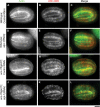
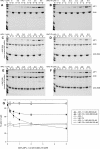
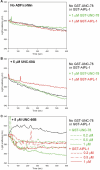
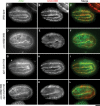
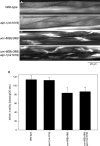

Similar articles
-
Functions of actin-interacting protein 1 (AIP1)/WD repeat protein 1 (WDR1) in actin filament dynamics and cytoskeletal regulation.Biochem Biophys Res Commun. 2018 Nov 25;506(2):315-322. doi: 10.1016/j.bbrc.2017.10.096. Epub 2017 Oct 19. Biochem Biophys Res Commun. 2018. PMID: 29056508 Free PMC article. Review.
-
Actin filament disassembling activity of Caenorhabditis elegans actin-interacting protein 1 (UNC-78) is dependent on filament binding by a specific ADF/cofilin isoform.J Cell Sci. 2003 Oct 15;116(Pt 20):4107-18. doi: 10.1242/jcs.00717. Epub 2003 Sep 2. J Cell Sci. 2003. PMID: 12953066
-
Two actin-interacting protein 1 isoforms function redundantly in the somatic gonad and are essential for reproduction in Caenorhabditis elegans.Cytoskeleton (Hoboken). 2014 Jan;71(1):36-45. doi: 10.1002/cm.21152. Epub 2013 Nov 8. Cytoskeleton (Hoboken). 2014. PMID: 24130131 Free PMC article.
-
Essential role of ADF/cofilin for assembly of contractile actin networks in the C. elegans somatic gonad.J Cell Sci. 2008 Aug 15;121(Pt 16):2662-70. doi: 10.1242/jcs.034215. Epub 2008 Jul 24. J Cell Sci. 2008. PMID: 18653537 Free PMC article.
-
Regulation of actin filament dynamics by actin depolymerizing factor/cofilin and actin-interacting protein 1: new blades for twisted filaments.Biochemistry. 2003 Nov 25;42(46):13363-70. doi: 10.1021/bi034600x. Biochemistry. 2003. PMID: 14621980 Review.
Cited by
-
Actin Filament Pointed Ends: Assays for Regulation of Assembly and Disassembly by Tropomodulin and Tropomyosin.Cytoskeleton (Hoboken). 2025 Feb 24:10.1002/cm.22007. doi: 10.1002/cm.22007. Online ahead of print. Cytoskeleton (Hoboken). 2025. PMID: 39992031 Free PMC article.
-
Functions of actin-interacting protein 1 (AIP1)/WD repeat protein 1 (WDR1) in actin filament dynamics and cytoskeletal regulation.Biochem Biophys Res Commun. 2018 Nov 25;506(2):315-322. doi: 10.1016/j.bbrc.2017.10.096. Epub 2017 Oct 19. Biochem Biophys Res Commun. 2018. PMID: 29056508 Free PMC article. Review.
-
UNC-87 isoforms, Caenorhabditis elegans calponin-related proteins, interact with both actin and myosin and regulate actomyosin contractility.Mol Biol Cell. 2015 May 1;26(9):1687-98. doi: 10.1091/mbc.E14-10-1483. Epub 2015 Feb 25. Mol Biol Cell. 2015. PMID: 25717181 Free PMC article.
-
CAS-1, a C. elegans cyclase-associated protein, is required for sarcomeric actin assembly in striated muscle.J Cell Sci. 2012 Sep 1;125(Pt 17):4077-89. doi: 10.1242/jcs.104950. Epub 2012 May 23. J Cell Sci. 2012. PMID: 22623720 Free PMC article.
-
Actin-interacting protein 1 controls assembly and permeability of intestinal epithelial apical junctions.Am J Physiol Gastrointest Liver Physiol. 2015 May 1;308(9):G745-56. doi: 10.1152/ajpgi.00446.2014. Epub 2015 Mar 19. Am J Physiol Gastrointest Liver Physiol. 2015. PMID: 25792565 Free PMC article.
References
-
- Aizawa H, Katadae M, Maruya M, Sameshima M, Murakami-Murofushi K, Yahara I. Hyperosmotic stress-induced reorganization of actin bundles in Dictyostelium cells over-expressing cofilin. Genes Cells. 1999;4:311–324. - PubMed
-
- Andrianantoandro E, Pollard TD. Mechanism of actin filament turnover by severing and nucleation at different concentrations of ADF/cofilin. Mol Cell. 2006;24:13–23. - PubMed
Publication types
MeSH terms
Substances
Grants and funding
LinkOut - more resources
Full Text Sources
Molecular Biology Databases
Research Materials
Miscellaneous

